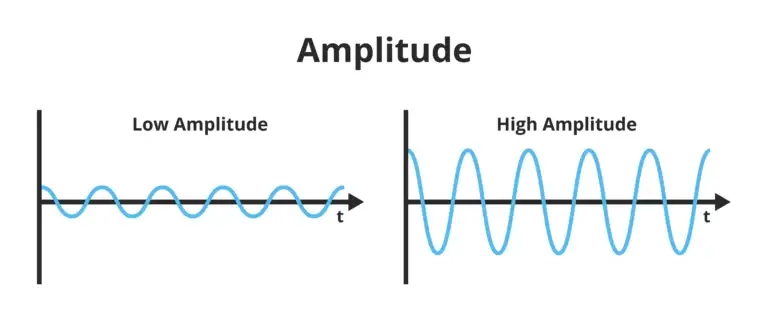Amplitude (Physics)

Table of Contents
What is Amplitude?
Amplitude represents the maximum displacement of a point on the wave or oscillating object from its equilibrium or rest position. It is measured in units that depend on the nature of the oscillation.
For mechanical waves, amplitude might be measured in meters or centimeters, indicating the physical displacement. Electrical signals could be measured in volts or amperes, representing the maximum change in the electrical quantity.
An Overview of Amplitude
Wave Motion
In wave motion, amplitude serves as an indicator of the wave’s strength or intensity. It measures how much the medium of the wave (like air for sound waves, water for ocean waves, or the material of a string for string vibrations) is displaced from its equilibrium or rest position when the wave propagates through it.
Strength and Intensity: The amplitude of a wave is directly related to its energy; larger amplitudes mean more energy. For instance, higher amplitudes translate to louder sounds in sound waves, which correspond to increased brightness or intensity in light waves.
Displacement: During wave propagation, particles or elements of the medium oscillate about their resting position. Amplitude is the maximum distance these particles move from their equilibrium position as the wave passes. It’s the wave’s peak height (for crests) or depth (for troughs) relative to the rest position.
Energy Transfer: The energy carried by a wave is often proportional to the square of its amplitude. This means that a small increase in amplitude can result in a significant increase in the energy transmitted by the wave. For example, in seismic waves, small increases in amplitude can significantly enhance the energy released during an earthquake, affecting its potential for damage.
Graphing Amplitude
Amplitude in wave diagrams is visually represented by the height of the wave peaks or the depth of its troughs from the equilibrium line. On a displacement-time graph, which shows how the displacement of the medium through which the wave travels varies with time, the amplitude is depicted as follows:
Equilibrium Position: This is the horizontal line on the graph that represents the rest position of the medium when no wave is passing through it. It’s the baseline from which the wave’s displacement is measured.
Peak: The highest point above the equilibrium line on the graph represents the wave’s peak. The wave’s amplitude is the vertical distance from the equilibrium position to this peak.
Trough: Conversely, the lowest point below the equilibrium line represents the wave’s trough. The amplitude is the vertical distance from the equilibrium line to the trough, but it’s measured in the opposite direction.
Maximum Displacement: Amplitude is the maximum displacement of the medium particles from their rest position, either upwards (peaks) or downwards (troughs).
Properties and Characteristics
Intensity: The intensity of a wave refers to the power transferred per unit area in the direction the wave is traveling. It is directly related to the square of the wave’s amplitude. This means that waves with larger amplitudes carry more energy and, therefore, have higher intensities. In physical terms, intensity is the amount of energy a wave conveys across a unit area per unit time. For example, in light waves, higher intensity means a brighter light. Sound waves correlate with the potential to cause more significant physical impacts on the medium through which they travel.
Loudness (for Sound Waves): In acoustics, the amplitude of sound waves is closely tied to the loudness or volume of the sound perceived by the human ear. Loudness is a subjective measure perceived by humans, but it directly relates to the objective measure of amplitude; sound waves with higher amplitudes are generally perceived as louder. The frequency of the sound wave also influences the human ear’s response to sound, but amplitude is a key factor in determining how loud a sound appears. For instance, whispering corresponds to sound waves of lower amplitude, while shouting produces waves of higher amplitude and, consequently, louder sound.
Periodic Motion and Amplitude
- Simple Harmonic Motion (SHM): In the context of oscillatory or vibrational motion, such as in simple harmonic motion, the amplitude is the maximum displacement of an object from its equilibrium position as it oscillates back and forth.
- Damped Oscillations: In damped oscillations, energy is gradually lost due to damping forces like friction or air resistance; the amplitude decreases over time.
Where Amplitude is Used
Physics: In physics, understanding amplitude is essential for analyzing and interpreting wave properties, including sound waves, light waves, and electromagnetic waves. It also plays a critical role in studying mechanical vibrations, oscillatory systems, and wave phenomena like interference and resonance. For example, in seismology, the amplitude of seismic waves helps determine the energy released by an earthquake, affecting how it is measured and analyzed.
Engineering: Engineers use knowledge of amplitude to design and construct structures and machinery that can endure the stresses of vibrations and oscillations. Understanding the amplitude of vibrations that buildings or bridges can withstand in civil engineering is crucial for earthquake-resistant design. In mechanical engineering, controlling the amplitude of vibrations can prevent damage to machinery and ensure efficient operation. The design of electronic circuits, especially in signal processing, also relies on understanding and manipulating amplitude.
Music and Acoustics: In music and sound engineering, amplitude is directly related to the loudness and intensity of sounds. Musicians and audio engineers adjust the amplitude of sound waves to achieve the desired loudness in musical performances and recordings. In sound system design, knowledge of amplitude is essential for creating systems that can accurately reproduce sound at different volumes and for understanding how sound behaves in different environments.
Amplitude Generator
Instructions: Adjust the slider to see how changing the amplitude affects the wave.
Related Links
Diffraction
Sound
The Doppler Effect
Refraction